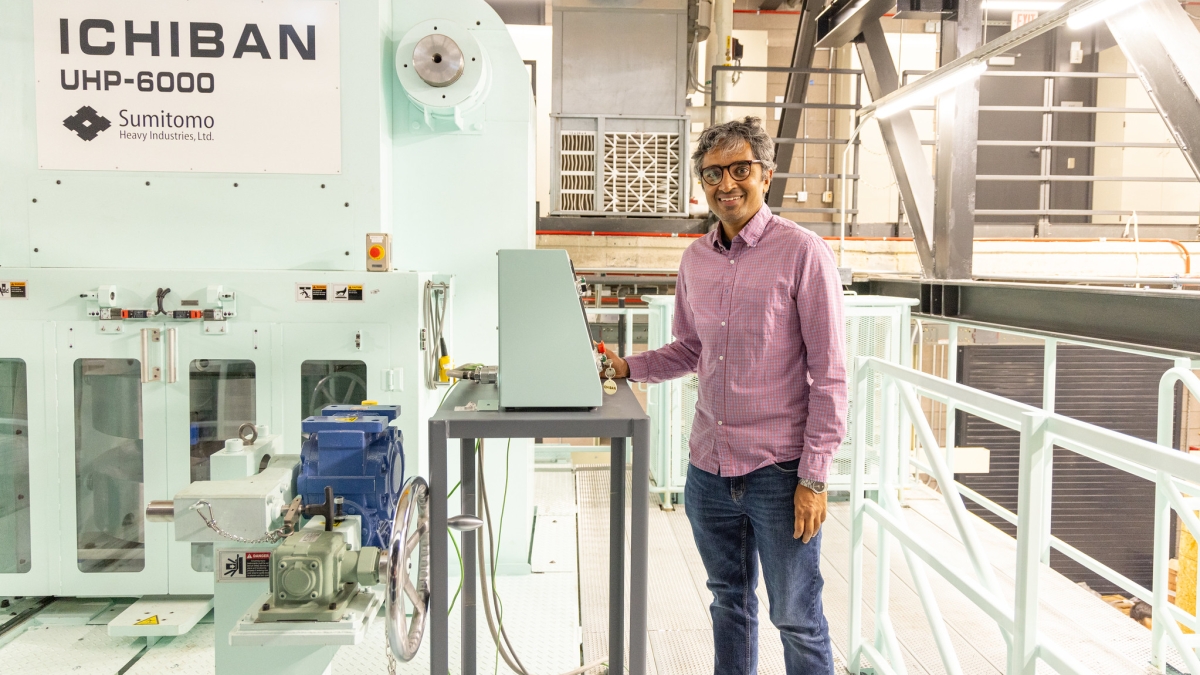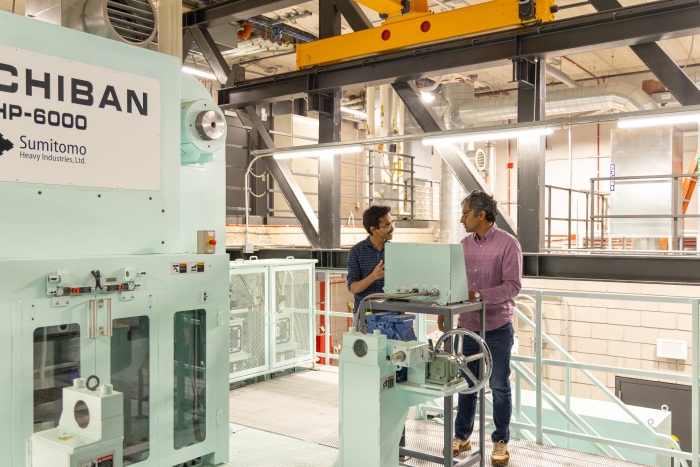Unlocking Earth's origins

Damanveer Grewal, assistant professor in Arizona State University’s School of Molecular Sciences, utilizes ASU's state-of-the-art high pressure experimental facilities at FORCE to understand the formation of habitable worlds in our solar system and beyond. Photo by Meghan Finnerty/ASU
Looking up at a vast, star-studded sky, people have always wondered: Are we alone in this universe?
It’s a fundamental question that has intrigued and inspired curious minds across all corners of our world. With recent advancements in science and research, this question, once thought to be purely philosophical, is becoming a perfectly testable hypothesis.
Damanveer Grewal, a cosmochemist and assistant professor in Arizona State University’s School of Molecular Sciences, studies the conditions of planet formation and how key elements like carbon, nitrogen, and water behave and are distributed as earth-like worlds form.
“In order for us to think about other potential life, we need to first understand the formation of earth itself, you need to understand the seeds,” said Grewal who also has a dual appointment in ASU’s School of Earth and Space Exploration. “My work aims to understand what happened in the seeds of earth’s formation, and I use high-pressure experiments and meteorites to benchmark data on.”
Grewal’s work allows scientists to gain a deeper understanding of how our own planet works, how Earth has sustained life, and provides clues about the far reaches of the solar system and beyond.
Exploring the inner workings of our planet
Earth did not form suddenly.
Over millions of years, born from a cloud of dust and gas that collapsed to form a spinning disk hovering in space, tiny particles clumped together to form rocks; those rocks collided with one another, melted together, and, over time, the planet grew.
But Earth is unique. During the formation process, just the right distribution of essential elements — nitrogen, carbon and water — remained on the planet, allowing for life to thrive.
Too much or too little of these critical elements during planet formation can have dramatic impacts on a planet's climate and environment.
“Venus has too much carbon dioxide in its atmosphere, making it inhabitable with surface temperatures of around 700 degrees Celsius,” Grewal said. “These are the things we need to understand: You can't have too many of these elements on the planet, but how do you find those sweet spots?”
Combining FORCE and meteorites
To find that elemental sweet spot, Grewal’s research uses ASU’s Facility for Open Research in a Compressed Environment, or better known as the FORCE facility, to recreate and put elements under the extreme conditions of early planet formation.
Within the state-of-the-art high-pressure experimental facilities, a variety of large presses crush, blast and heat rocks and elemental samples to trace the journey of these elements through each and every step of the planet formation sequence.
“This is a unique capability that no other university in the country has,” Grewal said.
Grewal then takes his work one step further by combining the high-pressure, high-temperature experiments with existing meteorite data. Meteorites provide valuable insights into the chemical composition of early bodies, almost as an elemental time capsule, while the experiments simulate the physical processes.
“What I'm interested in is trying to combine constraints on meteorite data and high-pressure experiments to understand processes that took place very, very, very early in the solar system history and then try to use that information to move ahead in time.”
Already, Grewal’s past work has contributed significantly to the field of astrochemistry, with several papers published in Nature Astronomy, upending a previously held notion that early planetesimals within the inner solar system didn't contain water, showing that they do, and in a separate paper uncovering that early planetesimals, or smaller protoplanets, within the inner solar system also contained nitrogen and carbon.
The freestyle scientist
For Grewal, he says, like anyone who’s ever looked up toward the night’s sky and gazed with wonder, his research is rooted in his own curiosity.
Through his research and teaching at ASU, he hopes to encourage his students to approach science as a creative endeavor.
“My passion as a human being is to understand things,” said Grewal, who created and teaches a new ASU class on the chemistry of planet formation. “(Research) has to be creative, it should be something that you're challenging, that brings interdisciplinary fields together, and of course when you're doing these kinds of risky sciences, sometimes you're going to be proven wrong, but that's also what moves science forward.
“I'm never going to constrain myself to what I know and what I don't know, and I want to instill that into my students and their research.”
Unbound, the possibilities — like the universe — are limitless.
More Science and technology

ASU postdoctoral researcher leads initiative to support graduate student mental health
Olivia Davis had firsthand experience with anxiety and OCD before she entered grad school. Then, during the pandemic and as a result of the growing pressures of the graduate school environment, she…

ASU graduate student researching interplay between family dynamics, ADHD
The symptoms of attention deficit hyperactivity disorder (ADHD) — which include daydreaming, making careless mistakes or taking risks, having a hard time resisting temptation, difficulty getting…

Will this antibiotic work? ASU scientists develop rapid bacterial tests
Bacteria multiply at an astonishing rate, sometimes doubling in number in under four minutes. Imagine a doctor faced with a patient showing severe signs of infection. As they sift through test…
